Dan Zhao
Large Language Model Scaling Laws for Neural Quantum States in Quantum Chemistry
Sep 16, 2025Abstract:Scaling laws have been used to describe how large language model (LLM) performance scales with model size, training data size, or amount of computational resources. Motivated by the fact that neural quantum states (NQS) has increasingly adopted LLM-based components, we seek to understand NQS scaling laws, thereby shedding light on the scalability and optimal performance--resource trade-offs of NQS ansatze. In particular, we identify scaling laws that predict the performance, as measured by absolute error and V-score, for transformer-based NQS as a function of problem size in second-quantized quantum chemistry applications. By performing analogous compute-constrained optimization of the obtained parametric curves, we find that the relationship between model size and training time is highly dependent on loss metric and ansatz, and does not follow the approximately linear relationship found for language models.
FEAT: Full-Dimensional Efficient Attention Transformer for Medical Video Generation
Jun 05, 2025Abstract:Synthesizing high-quality dynamic medical videos remains a significant challenge due to the need for modeling both spatial consistency and temporal dynamics. Existing Transformer-based approaches face critical limitations, including insufficient channel interactions, high computational complexity from self-attention, and coarse denoising guidance from timestep embeddings when handling varying noise levels. In this work, we propose FEAT, a full-dimensional efficient attention Transformer, which addresses these issues through three key innovations: (1) a unified paradigm with sequential spatial-temporal-channel attention mechanisms to capture global dependencies across all dimensions, (2) a linear-complexity design for attention mechanisms in each dimension, utilizing weighted key-value attention and global channel attention, and (3) a residual value guidance module that provides fine-grained pixel-level guidance to adapt to different noise levels. We evaluate FEAT on standard benchmarks and downstream tasks, demonstrating that FEAT-S, with only 23\% of the parameters of the state-of-the-art model Endora, achieves comparable or even superior performance. Furthermore, FEAT-L surpasses all comparison methods across multiple datasets, showcasing both superior effectiveness and scalability. Code is available at https://github.com/Yaziwel/FEAT.
WINA: Weight Informed Neuron Activation for Accelerating Large Language Model Inference
May 26, 2025Abstract:The growing computational demands of large language models (LLMs) make efficient inference and activation strategies increasingly critical. While recent approaches, such as Mixture-of-Experts (MoE), leverage selective activation but require specialized training, training-free sparse activation methods offer broader applicability and superior resource efficiency through their plug-and-play design. However, many existing methods rely solely on hidden state magnitudes to determine activation, resulting in high approximation errors and suboptimal inference accuracy. To address these limitations, we propose WINA (Weight Informed Neuron Activation), a novel, simple, and training-free sparse activation framework that jointly considers hidden state magnitudes and the column-wise $\ell_2$-norms of weight matrices. We show that this leads to a sparsification strategy that obtains optimal approximation error bounds with theoretical guarantees tighter than existing techniques. Empirically, WINA also outperforms state-of-the-art methods (e.g., TEAL) by up to $2.94\%$ in average performance at the same sparsity levels, across a diverse set of LLM architectures and datasets. These results position WINA as a new performance frontier for training-free sparse activation in LLM inference, advancing training-free sparse activation methods and setting a robust baseline for efficient inference. The source code is available at https://github.com/microsoft/wina.
FedOC: Optimizing Global Prototypes with Orthogonality Constraints for Enhancing Embeddings Separation in Heterogeneous Federated Learning
Feb 22, 2025

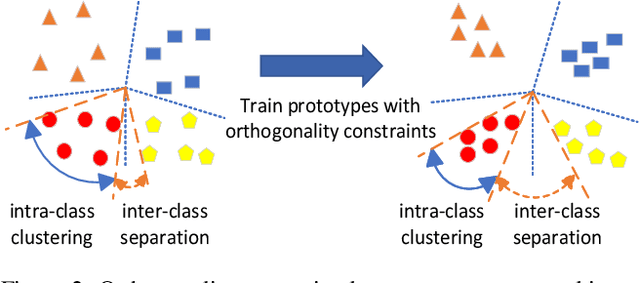

Abstract:Federated Learning (FL) has emerged as an essential framework for distributed machine learning, especially with its potential for privacy-preserving data processing. However, existing FL frameworks struggle to address statistical and model heterogeneity, which severely impacts model performance. While Heterogeneous Federated Learning (HtFL) introduces prototype-based strategies to address the challenges, current approaches face limitations in achieving optimal separation of prototypes. This paper presents FedOC, a novel HtFL algorithm designed to improve global prototype separation through orthogonality constraints, which not only increase intra-class prototype similarity but also significantly expand the inter-class angular separation. With the guidance of the global prototype, each client keeps its embeddings aligned with the corresponding prototype in the feature space, promoting directional independence that integrates seamlessly with the cross-entropy (CE) loss. We provide theoretical proof of FedOC's convergence under non-convex conditions. Extensive experiments demonstrate that FedOC outperforms seven state-of-the-art baselines, achieving up to a 10.12% accuracy improvement in both statistical and model heterogeneity settings.
Layer by Layer: Uncovering Hidden Representations in Language Models
Feb 04, 2025



Abstract:From extracting features to generating text, the outputs of large language models (LLMs) typically rely on their final layers, following the conventional wisdom that earlier layers capture only low-level cues. However, our analysis shows that intermediate layers can encode even richer representations, often improving performance on a wide range of downstream tasks. To explain and quantify these hidden-layer properties, we propose a unified framework of representation quality metrics based on information theory, geometry, and invariance to input perturbations. Our framework highlights how each model layer balances information compression and signal preservation, revealing why mid-depth embeddings can exceed the last layer's performance. Through extensive experiments on 32 text-embedding tasks and comparisons across model architectures (transformers, state-space models) and domains (language, vision), we demonstrate that intermediate layers consistently provide stronger features. These findings challenge the standard focus on final-layer embeddings and open new directions for model analysis and optimization, including strategic use of mid-layer representations for more robust and accurate AI systems.
Synthetic User Behavior Sequence Generation with Large Language Models for Smart Homes
Jan 31, 2025



Abstract:In recent years, as smart home systems have become more widespread, security concerns within these environments have become a growing threat. Currently, most smart home security solutions, such as anomaly detection and behavior prediction models, are trained using fixed datasets that are precollected. However, the process of dataset collection is time-consuming and lacks the flexibility needed to adapt to the constantly evolving smart home environment. Additionally, the collection of personal data raises significant privacy concerns for users. Lately, large language models (LLMs) have emerged as a powerful tool for a wide range of tasks across diverse application domains, thanks to their strong capabilities in natural language processing, reasoning, and problem-solving. In this paper, we propose an LLM-based synthetic dataset generation IoTGen framework to enhance the generalization of downstream smart home intelligent models. By generating new synthetic datasets that reflect changes in the environment, smart home intelligent models can be retrained to overcome the limitations of fixed and outdated data, allowing them to better align with the dynamic nature of real-world home environments. Specifically, we first propose a Structure Pattern Perception Compression (SPPC) method tailored for IoT behavior data, which preserves the most informative content in the data while significantly reducing token consumption. Then, we propose a systematic approach to create prompts and implement data generation to automatically generate IoT synthetic data with normative and reasonable properties, assisting task models in adaptive training to improve generalization and real-world performance.
Retentive Neural Quantum States: Efficient Ansätze for Ab Initio Quantum Chemistry
Nov 06, 2024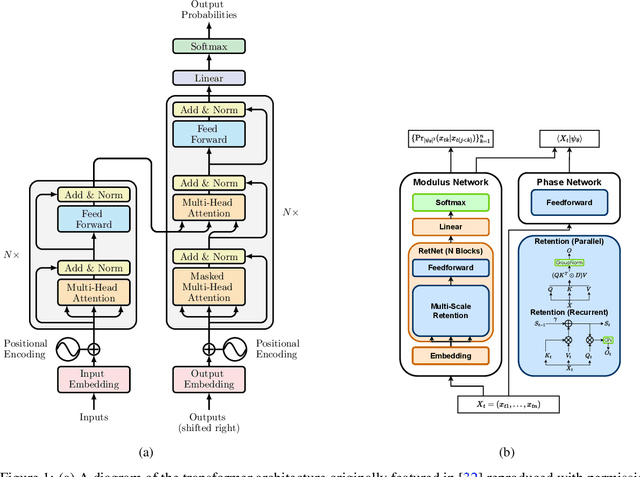



Abstract:Neural-network quantum states (NQS) has emerged as a powerful application of quantum-inspired deep learning for variational Monte Carlo methods, offering a competitive alternative to existing techniques for identifying ground states of quantum problems. A significant advancement toward improving the practical scalability of NQS has been the incorporation of autoregressive models, most recently transformers, as variational ansatze. Transformers learn sequence information with greater expressiveness than recurrent models, but at the cost of increased time complexity with respect to sequence length. We explore the use of the retentive network (RetNet), a recurrent alternative to transformers, as an ansatz for solving electronic ground state problems in $\textit{ab initio}$ quantum chemistry. Unlike transformers, RetNets overcome this time complexity bottleneck by processing data in parallel during training, and recurrently during inference. We give a simple computational cost estimate of the RetNet and directly compare it with similar estimates for transformers, establishing a clear threshold ratio of problem-to-model size past which the RetNet's time complexity outperforms that of the transformer. Though this efficiency can comes at the expense of decreased expressiveness relative to the transformer, we overcome this gap through training strategies that leverage the autoregressive structure of the model -- namely, variational neural annealing. Our findings support the RetNet as a means of improving the time complexity of NQS without sacrificing accuracy. We provide further evidence that the ablative improvements of neural annealing extend beyond the RetNet architecture, suggesting it would serve as an effective general training strategy for autoregressive NQS.
VideoWebArena: Evaluating Long Context Multimodal Agents with Video Understanding Web Tasks
Oct 24, 2024
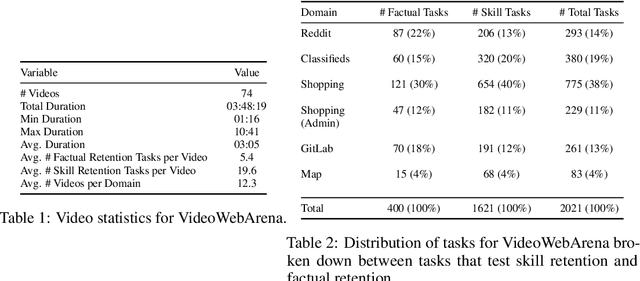
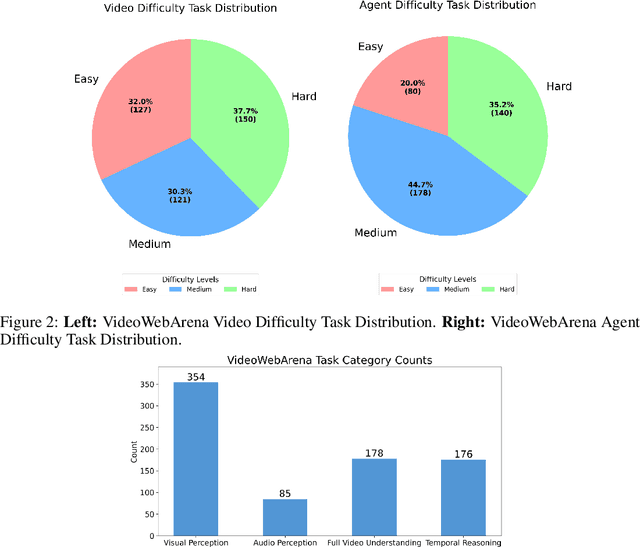
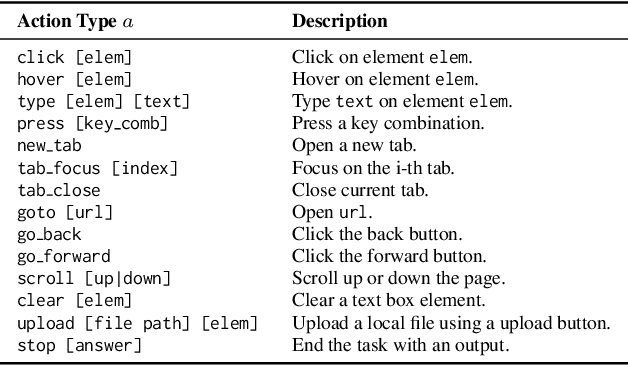
Abstract:Videos are often used to learn or extract the necessary information to complete tasks in ways different than what text and static imagery alone can provide. However, many existing agent benchmarks neglect long-context video understanding, instead focusing on text or static image inputs. To bridge this gap, we introduce VideoWebArena (VideoWA), a benchmark for evaluating the capabilities of long-context multimodal agents for video understanding. VideoWA consists of 2,021 web agent tasks based on manually crafted video tutorials, which total almost four hours of content. For our benchmark, we define a taxonomy of long-context video-based agent tasks with two main areas of focus: skill retention and factual retention. While skill retention tasks evaluate whether an agent can use a given human demonstration to complete a task efficiently, the factual retention task evaluates whether an agent can retrieve instruction-relevant information from a video to complete a task. We find that the best model achieves 13.3% success on factual retention tasks and 45.8% on factual retention QA pairs, far below human performance at 73.9% and 79.3%, respectively. On skill retention tasks, long-context models perform worse with tutorials than without, exhibiting a 5% performance decrease in WebArena tasks and a 10.3% decrease in VisualWebArena tasks. Our work highlights the need to improve the agentic abilities of long-context multimodal models and provides a testbed for future development with long-context video agents.
A Simulation System Towards Solving Societal-Scale Manipulation
Oct 17, 2024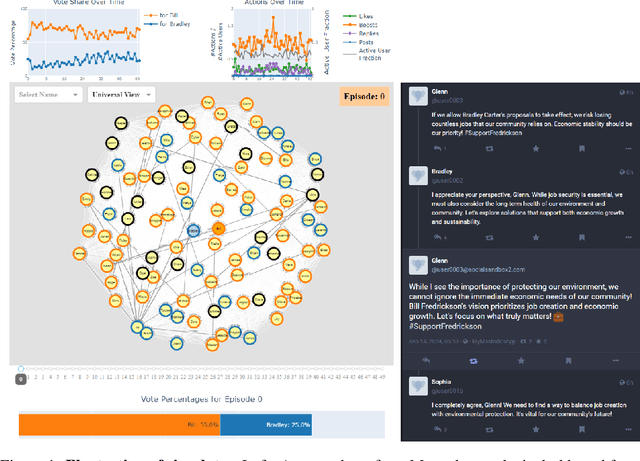


Abstract:The rise of AI-driven manipulation poses significant risks to societal trust and democratic processes. Yet, studying these effects in real-world settings at scale is ethically and logistically impractical, highlighting a need for simulation tools that can model these dynamics in controlled settings to enable experimentation with possible defenses. We present a simulation environment designed to address this. We elaborate upon the Concordia framework that simulates offline, `real life' activity by adding online interactions to the simulation through social media with the integration of a Mastodon server. We improve simulation efficiency and information flow, and add a set of measurement tools, particularly longitudinal surveys. We demonstrate the simulator with a tailored example in which we track agents' political positions and show how partisan manipulation of agents can affect election results.
Windows Agent Arena: Evaluating Multi-Modal OS Agents at Scale
Sep 12, 2024
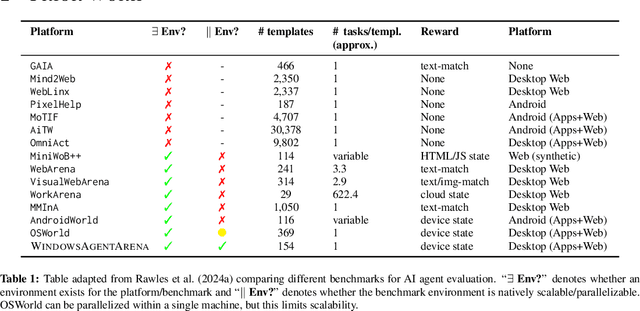
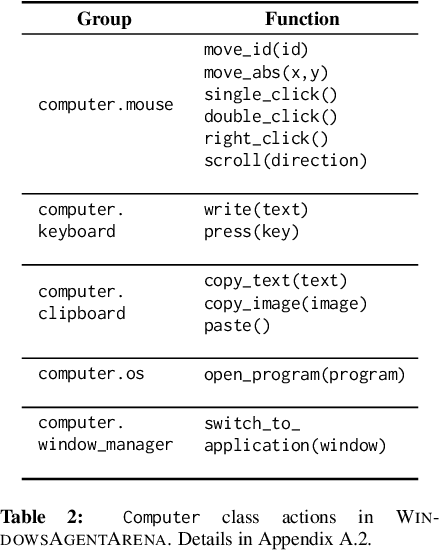
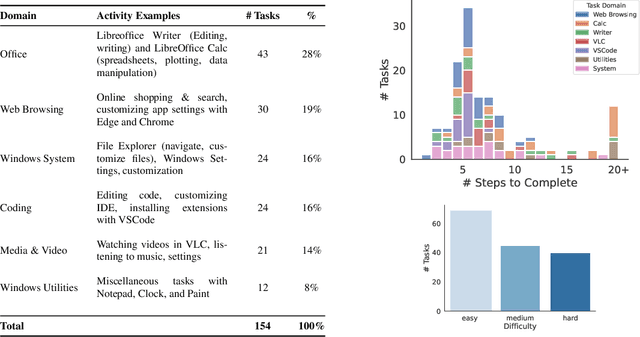
Abstract:Large language models (LLMs) show remarkable potential to act as computer agents, enhancing human productivity and software accessibility in multi-modal tasks that require planning and reasoning. However, measuring agent performance in realistic environments remains a challenge since: (i) most benchmarks are limited to specific modalities or domains (e.g. text-only, web navigation, Q&A, coding) and (ii) full benchmark evaluations are slow (on order of magnitude of days) given the multi-step sequential nature of tasks. To address these challenges, we introduce the Windows Agent Arena: a reproducible, general environment focusing exclusively on the Windows operating system (OS) where agents can operate freely within a real Windows OS and use the same wide range of applications, tools, and web browsers available to human users when solving tasks. We adapt the OSWorld framework (Xie et al., 2024) to create 150+ diverse Windows tasks across representative domains that require agent abilities in planning, screen understanding, and tool usage. Our benchmark is scalable and can be seamlessly parallelized in Azure for a full benchmark evaluation in as little as 20 minutes. To demonstrate Windows Agent Arena's capabilities, we also introduce a new multi-modal agent, Navi. Our agent achieves a success rate of 19.5% in the Windows domain, compared to 74.5% performance of an unassisted human. Navi also demonstrates strong performance on another popular web-based benchmark, Mind2Web. We offer extensive quantitative and qualitative analysis of Navi's performance, and provide insights into the opportunities for future research in agent development and data generation using Windows Agent Arena. Webpage: https://microsoft.github.io/WindowsAgentArena Code: https://github.com/microsoft/WindowsAgentArena
 Add to Chrome
Add to Chrome Add to Firefox
Add to Firefox Add to Edge
Add to Edge